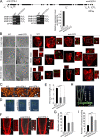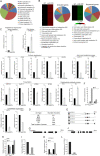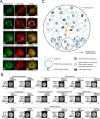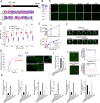Phase separation of Arabidopsis EMB1579 controls transcription, mRNA splicing, and development
- PMID: 32692742
- PMCID: PMC7413564
- DOI: 10.1371/journal.pbio.3000782
Phase separation of Arabidopsis EMB1579 controls transcription, mRNA splicing, and development
Erratum in
-
Correction: Phase separation of Arabidopsis EMB1579 controls transcription, mRNA splicing, and development.PLoS Biol. 2023 Apr 6;21(4):e3002095. doi: 10.1371/journal.pbio.3002095. eCollection 2023 Apr. PLoS Biol. 2023. PMID: 37023391 Free PMC article.
Abstract
Tight regulation of gene transcription and mRNA splicing is essential for plant growth and development. Here we demonstrate that a plant-specific protein, EMBRYO DEFECTIVE 1579 (EMB1579), controls multiple growth and developmental processes in Arabidopsis. We demonstrate that EMB1579 forms liquid-like condensates both in vitro and in vivo, and the formation of normal-sized EMB1579 condensates is crucial for its cellular functions. We found that some chromosomal and RNA-related proteins interact with EMB1579 compartments, and loss of function of EMB1579 affects global gene transcription and mRNA splicing. Using floral transition as a physiological process, we demonstrate that EMB1579 is involved in FLOWERING LOCUS C (FLC)-mediated repression of flowering. Interestingly, we found that EMB1579 physically interacts with a homologue of Drosophila nucleosome remodeling factor 55-kDa (p55) called MULTIPLE SUPPRESSOR OF IRA 4 (MSI4), which has been implicated in repressing the expression of FLC by forming a complex with DNA Damage Binding Protein 1 (DDB1) and Cullin 4 (CUL4). This complex, named CUL4-DDB1MSI4, physically associates with a CURLY LEAF (CLF)-containing Polycomb Repressive Complex 2 (CLF-PRC2). We further demonstrate that EMB1579 interacts with CUL4 and DDB1, and EMB1579 condensates can recruit and condense MSI4 and DDB1. Furthermore, emb1579 phenocopies msi4 in terms of the level of H3K27 trimethylation on FLC. This allows us to propose that EMB1579 condensates recruit and condense CUL4-DDB1MSI4 complex, which facilitates the interaction of CUL4-DDB1MSI4 with CLF-PRC2 and promotes the role of CLF-PRC2 in establishing and/or maintaining the level of H3K27 trimethylation on FLC. Thus, we report a new mechanism for regulating plant gene transcription, mRNA splicing, and growth and development.
Conflict of interest statement
The authors have declared that no competing interests exist.
Figures






Similar articles
-
MSI4/FVE interacts with CUL4-DDB1 and a PRC2-like complex to control epigenetic regulation of flowering time in Arabidopsis.Proc Natl Acad Sci U S A. 2011 Feb 22;108(8):3430-5. doi: 10.1073/pnas.1018242108. Epub 2011 Jan 31. Proc Natl Acad Sci U S A. 2011. PMID: 21282611 Free PMC article.
-
Repression of FLOWERING LOCUS C and FLOWERING LOCUS T by the Arabidopsis Polycomb repressive complex 2 components.PLoS One. 2008;3(10):e3404. doi: 10.1371/journal.pone.0003404. Epub 2008 Oct 14. PLoS One. 2008. PMID: 18852898 Free PMC article.
-
Brassinosteroid Signaling Recruits Histone 3 Lysine-27 Demethylation Activity to FLOWERING LOCUS C Chromatin to Inhibit the Floral Transition in Arabidopsis.Mol Plant. 2018 Sep 10;11(9):1135-1146. doi: 10.1016/j.molp.2018.06.007. Epub 2018 Jun 30. Mol Plant. 2018. PMID: 29969683
-
The complexity of PRC2 catalysts CLF and SWN in plants.Biochem Soc Trans. 2020 Dec 18;48(6):2779-2789. doi: 10.1042/BST20200660. Biochem Soc Trans. 2020. PMID: 33170267 Review.
-
An insight into understanding the coupling between homologous recombination mediated DNA repair and chromatin remodeling mechanisms in plant genome: an update.Cell Cycle. 2021 Sep;20(18):1760-1784. doi: 10.1080/15384101.2021.1966584. Epub 2021 Aug 26. Cell Cycle. 2021. PMID: 34437813 Free PMC article. Review.
Cited by
-
Size conservation emerges spontaneously in biomolecular condensates formed by scaffolds and surfactant clients.Sci Rep. 2021 Jul 27;11(1):15241. doi: 10.1038/s41598-021-94309-y. Sci Rep. 2021. PMID: 34315935 Free PMC article.
-
Widespread premature transcription termination of Arabidopsis thaliana NLR genes by the spen protein FPA.Elife. 2021 Apr 27;10:e65537. doi: 10.7554/eLife.65537. Elife. 2021. PMID: 33904405 Free PMC article.
-
Progressive chromatin silencing of ABA biosynthesis genes permits seed germination in Arabidopsis.Plant Cell. 2022 Jul 30;34(8):2871-2891. doi: 10.1093/plcell/koac134. Plant Cell. 2022. PMID: 35522002 Free PMC article.
-
Sequence variations of phase-separating proteins and resources for studying biomolecular condensates.Acta Biochim Biophys Sin (Shanghai). 2023 Jul 18;55(7):1119-1132. doi: 10.3724/abbs.2023131. Acta Biochim Biophys Sin (Shanghai). 2023. PMID: 37464880 Free PMC article. Review.
-
The Importance of Networking: Plant Polycomb Repressive Complex 2 and Its Interactors.Epigenomes. 2022 Mar 3;6(1):8. doi: 10.3390/epigenomes6010008. Epigenomes. 2022. PMID: 35323212 Free PMC article. Review.
References
Publication types
MeSH terms
Substances
Grants and funding
LinkOut - more resources
Full Text Sources
Other Literature Sources
Molecular Biology Databases
Research Materials

